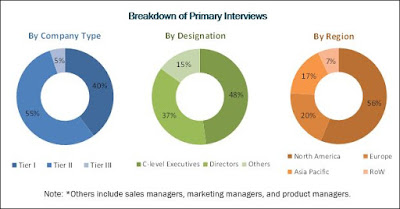The increasing adoption of mesh in hernia repair surgeries, rising geriatric population, new product developments, and efficient reimbursement system in developed countries are the major factors driving the growth of the hernia mesh repair surgery market during the forecast period.
The Laparoscopic Surgery Market is expected to reach USD 3.53 Billion by 2022 from USD 3.18 Billion in 2017, at a CAGR of 2.1% during forecast period.
Objectives of the Study:
# To define, describe, and forecast the hernia mesh repair surgery market, by type of surgery and type of mesh fixator (glue & tack applicator).
# To strategically analyze micromarkets with respect to individual growth trends, future prospects, and contributions to the overall laparoscopic surgery market.
# To forecast the size of the market segments with respect to specific countries .
# To profile the key players and comprehensively analyze their core competencies.
# To track and analyze competitive developments such as product launches; agreements, partnerships, and joint ventures; mergers and acquisitions; and research and development activities in the hernia mesh repair surgery market.
In 2017, the open hernia repair surgery segment accounted for the largest share of the hernia mesh repair surgery market in 2017. Open hernia repair does not require any advanced equipment and takes 25% lesser time than laparoscopy. This makes open hernia repair more cost effective.
Moreover, this type of surgery is preferred for hernias that have been present for a long period of time. However, the laparoscopic hernia repair surgery segment is expected to register the highest growth rate during the forecast period, owing to factors such as less postoperative pain, less chances of wound infection, and early recovery.
Read More Details | Get the Sample Pages@ http://bit.ly/2twlKJ1
The report covers the hernia mesh repair surgery market across ten countries, namely, the US, Canada, Germany, France, the UK, Italy, Spain, Japan, China, and India. The US accounted for the largest share of the hernia mesh repair surgery market in 2017.
The large share of the US is attributed to the large patient population, increasing adoption of technologically advanced products, and presence of a well-established medical reimbursement policy in the country. However, India is expected to register the highest growth rate during the forecast period, owing to the improving healthcare infrastructure and increasing patient population in the country.
The major players of the hernia mesh repair surgery market profiled in this report are Medtronic (Ireland), Johnson & Johnson (US), B. Braun (Germany), C. R. Bard (US), and W.L. Gore (US).
Stakeholders:
# Manufacturers of hernia mesh and mesh fixators
# Raw material suppliers
# Market research and consulting firms
# Regulatory bodies
# Venture capitalists
# Hospitals


